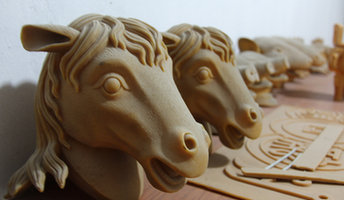Tongling's bronze history in the present
- By Stuart Wiggin
 0 Comment(s)
0 Comment(s) Print
Print E-mail CRI, November 13, 2013
E-mail CRI, November 13, 2013
A worker chips away at a design placed on top of a sheet of copper with a hammer and chisel at the Tongling Xinjiuding Bronze Culture Industry Company, in Tongling city, Anhui Province, November 11, 2013. [Photo: CRIENGLISH.com/Wu Tong]
Many Chinese people associate Anhui Province with "Chang Jiang river", better known in the west as the Yangtze river, and the Huangshan mountain range. But the province is also home to the third biggest copper base in the world in the form of Tongling City. Alongside Tongling's smelting factories sits a small warehouse which produces hand-crafted sculptures, which provide an insight into the city's past.
Tongling city, located in the south of Anhui Province, along the middle and lower reaches of the southern stretch of the Yangtze river, is a city with a bronze past. It was one of the birthplaces of bronze culture, thanks to the huge deposits of copper within the area. Today, the copper deposits fuel the local copper smelting industry. At the Amer Tongling Copper Technology factory, machines constantly churn out meters upon meters of copper wire. The factory produces around 250,000 tonnes of copper wire per year.
Ms. Chen, a spokesperson with the Amer Tongling Copper Technology Company notes that, "Tongling's mineral and metal deposits are abundant, especially copper. Electrolytic copper sheets are the raw materials that provide the basis for the development of the copper industry."
The development area in which the Amer factory is located attracts a number of companies thanks to the abundance of skilled labour on hand. Jin Zhong, deputy Party secretary of Tongling Economic Development Zone, explains that the area has technical schools that have been producing skilled workers for the past 4-5 decades. "We have this many technical schools, and every technical school has around 500 students every semester. So many schools over so many years have trained a large group of skilled workers, thus cultivating a good foundation upon which Tongling can grow."
But not all of these skilled labourers are being put to work in smelting plants. Five minutes down the road from the Amer factory is the Tongling Xinjiuding Bronze Culture Industry Company; a place where labourers utilise their metalworking skills to produce beautiful bronze sculptures and panel work. Throughout the Xinjiuding workshop, the sound of tools hitting metal can be heard as workers hammer away at sheets of copper in a dimly lit space. Using a hammer and chisel, the workers carefully chip away at elaborate designs measuring four to five feet in length.
Elsewhere in the Tongling Xinjiuding workshop, wax models are crammed onto shelves and spread across the studio floors while larger casts are propped up against the walls. Zheng Dongping, a senior craftsman at the company points out that in order to create bronze sculptures, workers must follow fifteen steps just to create a mould. Wax is a vital component in the creation of the bronze sculptures. Wax models are first hand carved and then covered in a special fireproof cement-like substance which is baked in a kiln in order to create the moulds in which the bronze sculptures are cast. The fifteen individual steps take around a month to complete.
As wax is such an important part of the process, utilised in fourteen of the fifteen steps needed to create a mould, it is essential that the wax models do not warp or break during the process. As Zheng Dongping explains, "According to the season, we have to add different materials [to the wax]. In summer, the wax is soft and easily melts, so we have to add something in order to make it stay hard. In winter, the wax is brittle, so we have to soften it."
As for the final stages of making a mould, Zheng Dongping states, "The wax is wrapped in fireproof materials. After these [materials] dry, we expose them to high temperatures and high pressure which will melt the wax inside. This method removes the wax, producing an empty mould. We take this mould and put it into a kiln until it's hard enough to use as a mould in which to cast bronze."
All in all, the process is a lengthy one, though the rewards are high. Prices range from a few thousand to hundreds of thousands depending on the design. Artists and workers at the Tongling Xinjiuding workshop work hard to honour the history of the area. As a result, the city is seen as one of the premier locations for bronze work in the world.
Thanks to its high reputation within the field, the company holds an international bronze art exhibition every two years and invites artists from all over the world to submit their designs. An organising committee selects the most outstanding pieces and invites the selected artists to come to Tongling to complete their work. The finished item is then placed in the Tongling bronze sculpture park, where the area's proud history is on display for all to see.






Go to Forum >>0 Comment(s)